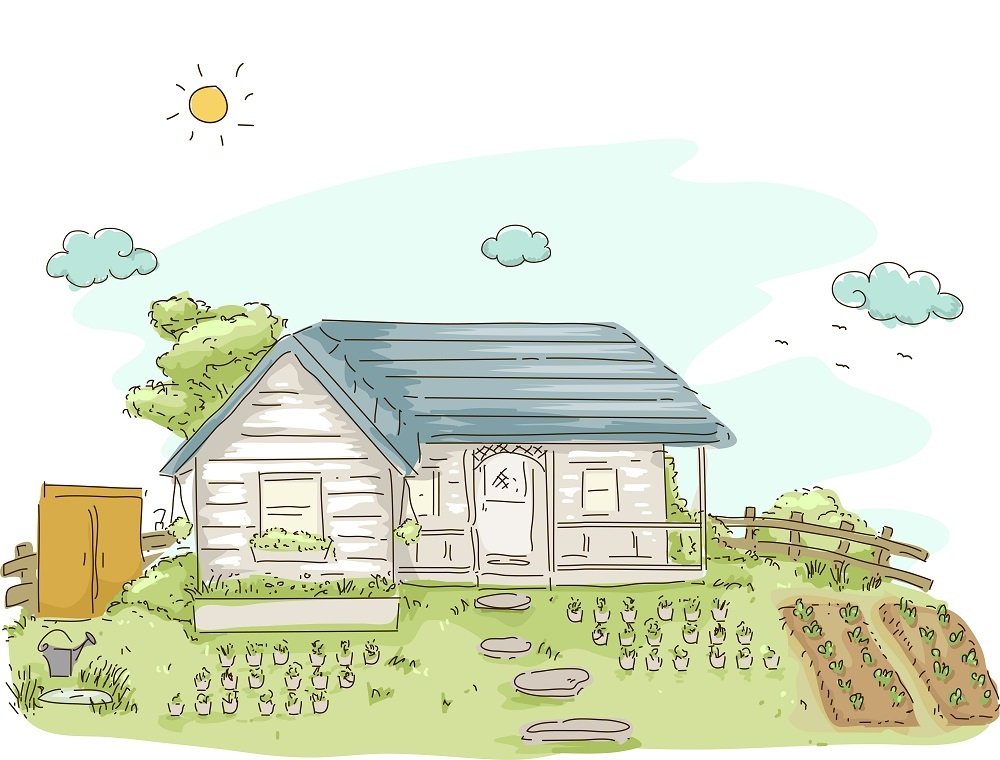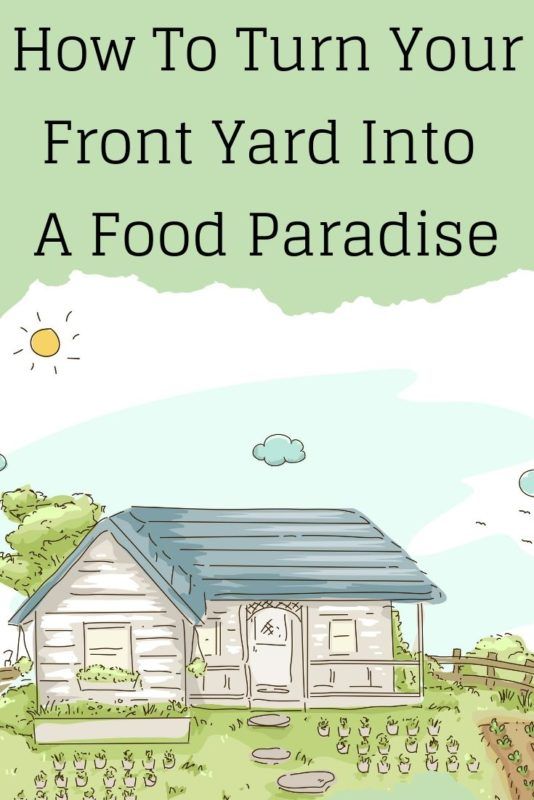
While grass is nice and ordinary for front lawns, have you ever considered how amazing it would be to turn that grassy spot into a delicious food paradise?
Yes, it is a bit unconventional but imagine how much food you could produce even in the smallest of front yards. Often we reserve our front yards for presenting “curb appeal.”
However, it can be seriously wasted space especially if you have a shady backyard and can’t grow much behind your house. Why not utilize your property as productively as possible?
There are many advantages to growing your own food including saving money, improving your health and creating a fun family project or hobby.
When done correctly, a food oasis can be beautiful as well as bountiful. How sweet it would be to take a stroll out to get the morning newspaper and pluck an apple and some berries for breakfast on the way.
There are actually several organizations whose sole purpose it is to help people transform their lawns into an edible oasis. The company Edible Estates was created to transform lawns that guzzle water and eat up pesticides into functional and fruitful gardens.
According to the brainchild behind Edible Estates, Fritz Haeg,
“The lawn devours resources while it pollutes. It is maniacally groomed with mowers and trimmers powered by the 2-stroke motors responsible for much of our greenhouse gas emissions. Hydrocarbons from mowers react with nitrogen oxides in the presence of sunlight to produce ozone. To eradicate invading plants, it is drugged with pesticides which are then washed into our water supply with sprinklers and hoses, dumping our increasingly rare fresh drinking resource down the gutter. Of the 30 commonly used lawn pesticides, 17 are detected in groundwater and 23 have the ability to leach into groundwater sources. The lawn divides and isolates us. It is the buffer of anti-social no-man’s-land that we wrap ourselves with, reinforcing the suburban alienation of our sprawling communities. The mono-culture of one plant species covering our neighborhoods from coast to coast celebrates puritanical homogeneity and mindless conformity.”
First Things First…. The Edible Front Lawn Journey Begins
If you aren’t up for hiring someone to transform your yard, there are numerous websites and books available for guidance. One very good book is Food Not Lawns and Paradise Lot is also a great reference guide for those living in urban settings.
A Few Things To Consider When Planning For Your Edible Yard:
- Do the covenants in your neighborhood have rules against planting an edible yard?
- Is your front yard sunny? If so, how much sun does it get?
- Have there been extensive chemicals applied to your lawn?
- What types of food are you interested in growing?
- Are you going to include any sitting areas or leave a patch of grass?
- Will you use mostly raised beds and containers or will you plant directly into the soil or a combination of both?
- How much time and money do you want to put into your garden?
- Will you install a fence to keep critters out? If so, do you know where your easements are?
How To Get Started Creating Your Front Yard Food Paradise
- Get permission from any regulating groups to create a food landscape. Homeowners associations may require that you submit drawings and specific plans for your garden.
- Measure your front lawn and create a scale drawing of your food paradise. Include pathways, sitting areas, and places where you are going to use containers for growing, etc…
- The more detailed you can be with your plans the easier it will be when you get ready to purchase and plant your paradise.
- Mark all utilities and lines in your lawn.
- Conduct a soil test to determine your soil type and to see if there are any lawn chemicals in the soil.
- Use marking chalk, stakes, and strings to mark out your garden boundaries, walkways, and any themed areas according to your written plan.
- Use a sod cutter to clear away grass. If you can, roll it up or save it to transplant elsewhere. Alternatively, you can just cover the lawn with raised beds.
- Install a drip irrigation system – preferably attached to rain barrels.
- If you are planting directly into the soil, be sure to add a generous amount of rich compost, manure, mushroom soil, earthworm castings or any other rich, organic soil amendments you may have.
- Purchase and plant per your plan, using edibles that are suitable for your growing zone.
- Keep in mind that the first season should be a trial only to see how things go and grow. There will be some trial and error until you discover the best plants to grow.
Tips & Tricks & Principles For Success
Here are a few trick and tips to create an eye-catching and delicious front yard food paradise.
Keep It Simple
–Replace existing shrubs with an edible hedge. A great option is currant bushes.
Lines
Curved borders and walkways create an appealing line to any garden space. Rocks or bricks make great border options.
Unity
A well-designed garden will unify the space using eye-catching blocks of color and texture. This principle applies equally to creating any type of garden, even a food oasis. To accomplish unity use beautiful flowers as well as fruit, veggies, and herbs in your landscape.
Focal Points
Plant specimen trees to create focal points in your edible landscape. Good options include dwarf cherry, draft apple or dwarf peach. Keep your focal points in the dwarf size so that they don’t overpower your front lawn.
Existing Structures
Fruit trees and vines can be trained to grow along an existing fence or wall.
Best Plants For An Edible Landscape
Here are some of the best plants to consider when creating your front yard food paradise. Many of them are unattractive to critters who might also be thrilled that you are planting a delicious grocery store of goodies in your front yard!
Artichokes: These imposing plants are prickly so there are not many animals that are interested in eating them.
Beans: Trellising beans can create attractive living ornaments in your landscape. Both the leaves and flowers are very pretty. A simple bamboo teepee creates height as well. Most animals find the leaves more attractive than the beans themselves so your harvest will usually be unharmed.
Herbs: Perennial herbs add texture, color, and fragrance to any garden. As an added bonus, animals generally prefer annual herbs over perennial herbs. Woodier herbs such as oregano, thyme, rosemary, sage, and lavender are excellent choices.
Edible flowers: Edible flowers are especially attractive in containers dribbled throughout your garden. Nastursiums, pansies, roses, violets and sage flowers are easy to grow and will reward you with beautiful blooms and make a tasty addition to any salad.
Eggplants: Eggplants are beautiful vegetables that add a delicious touch of interest to any food paradise.
Onions, garlic, and chives: You may find these alliums delicious but animals won’t touch them. To keep your food paradise safe, plant garlic, chives, and onions in between other plants. Chives can spread quickly so don’t let them go to seed. Since garlic and onions need to be dug up when harvested, they are best planted around garden bed borders.
Fruit, nuts, and berries: With a little netting for protection you can plant a wide variety of fruit, nuts, and berries. One of the best things about planting fruit, nuts, and berries is that they are fairly low maintenance. Fruit shrubs especially are quite beautiful with pretty flowers and beautiful berries. Blueberries are also beautiful in the fall showcasing radiant red leaves.
What Not To Grow In Your Edible Landscape
Just as there are plants that work well in an edible landscape, there are others that flash a sign for a free animal buffet. If you don’t want your food paradise trampled stay clear of these:
Greens – Deer and groundhogs especially love to feast on greens. Unless you have a good fence to keep them out – avoid greens like lettuce, kale, chard, etc.
Corn – Squirrels are especially attracted to corn and love to bend the stalks and munch on cobs.
Peas – Planting delicious and sweet peas is like ringing the dinner bell for local deer, rabbits, groundhogs and more. If you really desire peas, you might have to fence them in.
Happy planting!
Pin This To Save For Later

